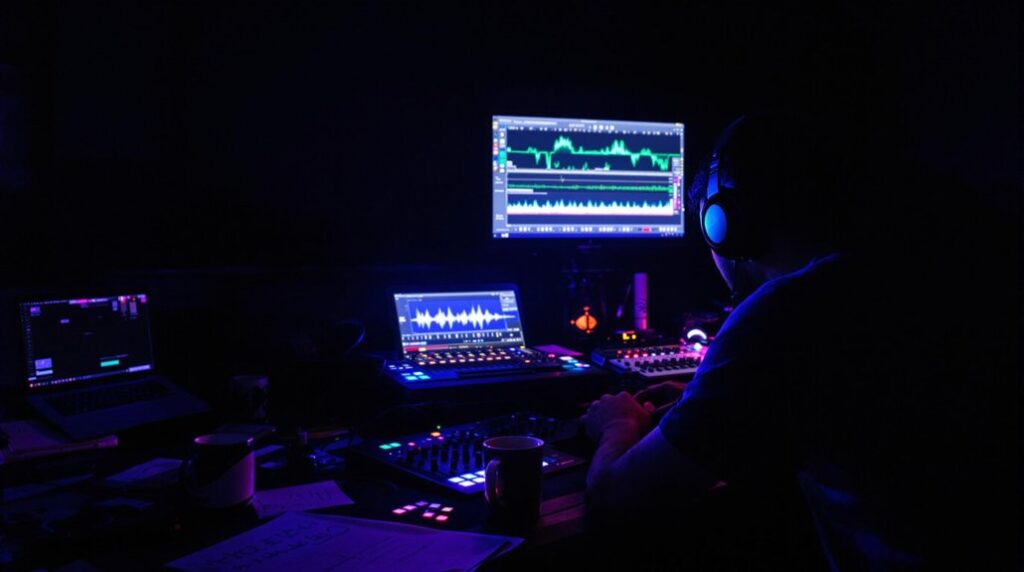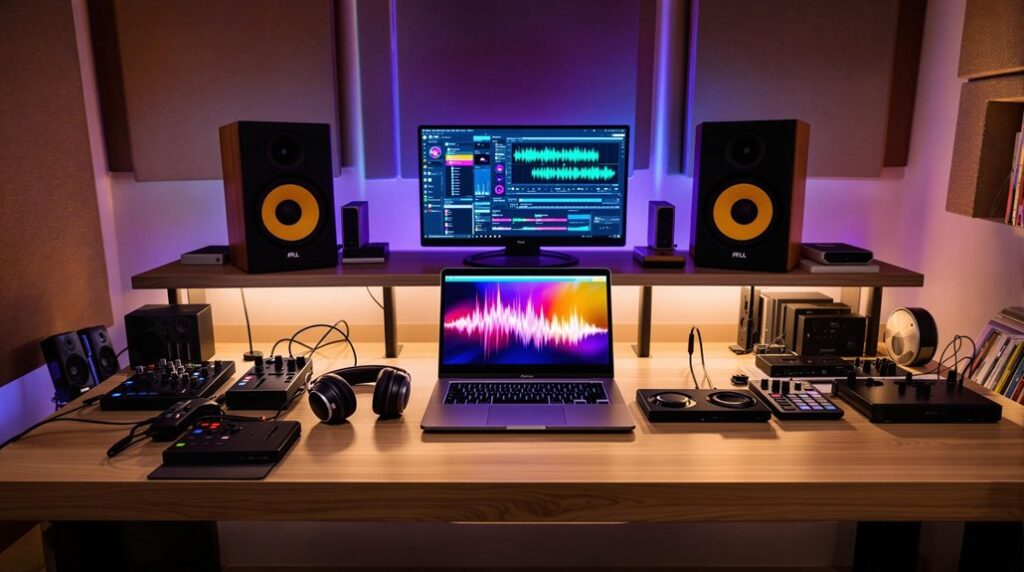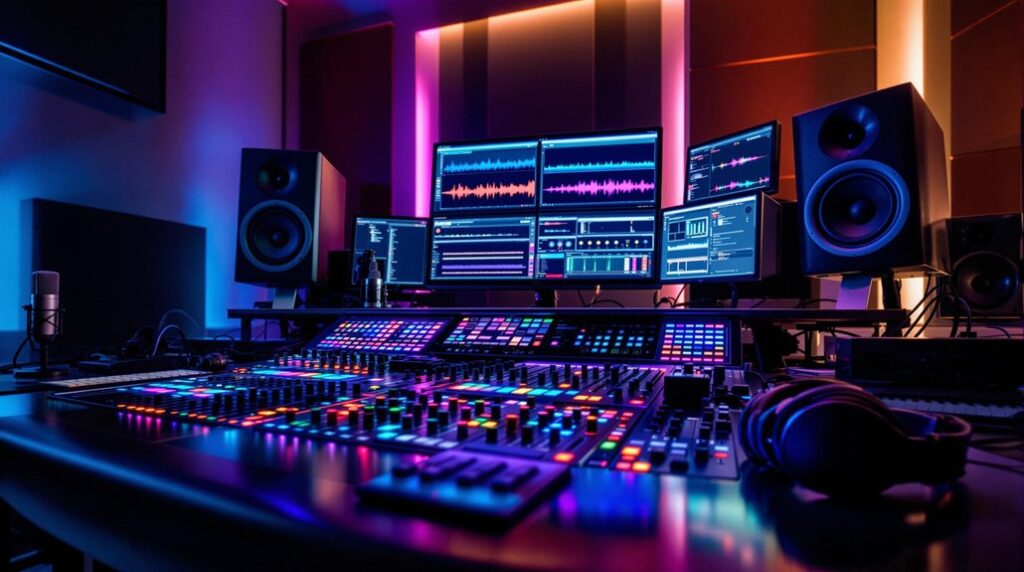To create a wide stereo image in your mix, start by mixing in mono to address frequency balance. Use mid-side EQ to secure low frequencies and clarify the stereo field. Apply reverb strategically with longer decay times and experiment with pre-delay settings to add depth. Utilize hard panning for extreme width and automate panning for dynamic separation. Double tracking and microshifting can create variation and richness. Employ the Haas effect by delaying one channel and panning it. Proper speaker placement and use of reference tracks guarantee accurate monitoring. For more advanced techniques and precise adjustments, keep exploring.
Key Takeaways
- Use panning to assign spatial positions and create width in your mix.
- Apply mid-side EQ to boost highs and cut lows on side channels for enhanced stereo width.
- Utilize reverb with longer decay times to add depth and spaciousness to your mix.
- Employ the Haas Effect by delaying one channel and panning towards the delayed side for spatial depth.
- Automate panning movements to inject dynamic width and prevent mix clutter.
Understanding Stereo Imaging
Understanding stereo imaging is vital because it allows you to create a mix where each instrument has its own space and contributes to a wide, immersive sound. At the heart of this concept is the stereo field, a virtual space where you position your audio elements to achieve clarity and separation.
By manipulating the stereo field, you can guarantee that each instrument occupies a distinct location, preventing clutter and enhancing the listener’s experience.
Pan positioning is a key technique to achieve effective stereo imaging. This involves adjusting the balance of an audio signal between the left and right channels. For instance, you might pan rhythm guitars to the left and right to create width, while keeping the lead vocals centered for focus.
Additionally, subtle differences in level, phase, and timing between channels can further enhance the perception of space.
Effective use of monitors is vital when making these adjustments. High-quality speakers or headphones help you accurately assess the stereo image and make precise decisions. Always consider the crossfeed phenomenon, where sounds bleed between channels, as it impacts your perception of the stereo field.
Start Mixing in Mono
To enhance the clarity and balance of your stereo image, begin by mixing in mono to focus on the core elements of your mix. This approach guarantees that your track will maintain mono compatibility, an essential factor for various playback systems. Mixing in mono reveals intricate details that could be masked in a stereo field, allowing you to address frequency balance issues head-on.
Here’s why starting in mono is important:
- Frequency Balance: By limiting spatial perception, you can identify and correct frequency clashes in the presence zone. This helps ensure that key elements like vocals and snare drums stand out without overwhelming other parts of your mix.
- Mix Translation: Fixes made in mono translate effectively to stereo. When you later expand to stereo, your mix will sound cohesive and balanced across different playback systems.
- Phase Issues: Avoid panning low frequencies in mono to maintain groove and rhythm integrity. This minimizes phase cancellation problems, ensuring your mix retains its punch and clarity.
Effective EQ Techniques
To create a wide stereo image, you need to focus on frequency separation and EQ balance. Use mid-side EQ to monoize low frequencies and remove excess low-end from the sides, which clarifies the mix and opens up the stereo field.
Additionally, panning combined with precise EQ adjustments can help maintain balance and avoid muddiness, ensuring a consistent and expansive stereo image.
Frequency Separation Strategy
Leveraging EQ techniques, you can achieve a wider stereo image by strategically separating frequencies between the mid and side channels. This method enhances stereo width and guarantees frequency balance within your mix. By employing mid-side EQ, you can precisely control which frequencies are more prominent in the center (mid) and which are emphasized on the sides.
Highs and Lows Adjustment: Boost the high frequencies and cut the low frequencies on the side channels. This technique widens the stereo image, giving your mix more depth and clarity.
Mid-Side EQ: Use mid-side EQ to adjust frequencies in the mid and side channels separately. For instance, you might boost midrange frequencies in the mid channel while attenuating them in the side channels to create a more open mix.
Frequency Carving: Carve out space for different instruments using EQ. Guarantee each instrument has its own designated frequency range, reducing overlap and increasing separation in the stereo field.
Panning and EQ Balance
Building on the principles of frequency separation, effective panning and EQ balance are pivotal for refining the stereo image and creating a cohesive mix. To achieve ideal stereo width, start by using EQ balancing to make sure that each element occupies a distinct frequency range. This approach allows instruments to breathe, preventing clutter and enhancing spatial depth.
Utilize EQ adjustments specifically in the presence zone (around 4-6 kHz) to accentuate stereo image width. By carefully boosting or cutting frequencies in this range, you can bring forward or push back elements within the stereo field. This technique helps in shaping the stereo image, making it more dynamic and engaging.
Moreover, balancing frequencies between the mid and side channels is essential. Use mid/side EQ to sculpt the stereo width of specific frequency bands, ensuring that low-frequency elements remain centered while higher frequencies can be spread wider. This separation creates a more immersive and expansive soundstage.
Lastly, remember that proper EQing can create space and depth. By controlling the width of specific frequency bands, you can direct the listener’s focus, making your mix sound more polished and professional.
Implement these EQ techniques to master the art of stereo imaging in your mixes.
Utilize Reverb Strategically
Selecting reverb with longer decay times can create a profound sense of depth and spaciousness in your mix. To achieve this, you’ll need to explore various reverb applications and creative settings. Apply reverb primarily to elements situated in the middle to back of the mix. This enhances spatial depth and makes your mix feel more immersive.
Consider these techniques to achieve best results:
- Pre-delay Settings:
Experiment with pre-delay to add separation and clarity to sound sources. A slight pre-delay can prevent reverb from muddying the mix while maintaining spatial enhancement.
- Types of Reverb:
Use different types of reverb such as plate, hall, and room. Each type simulates unique acoustic environments, contributing to mix depth and enhancing stereo width.
- Wet/Dry Mix Control:
Adjust the wet/dry mix to regulate the amount of space and width added. A higher wet mix can make an element feel more distant, while a lower wet mix retains its presence.
Strategically utilizing reverb in these ways will amplify the overall depth and spaciousness of your mix, ensuring each element occupies its intended space effectively.
Panning for Width
Panning audio signals within the stereo field creates a sense of width and separation, crucial for a clear and immersive mix. By strategically placing sounds across the stereo spectrum, you can achieve stereo enhancement and effective spatial positioning.
Hard panning—placing sounds fully to the left or right—adds extreme width and can create a dramatic effect. However, subtle panning often results in a more natural and balanced stereo image, guaranteeing elements don’t overpower one another.
Automating panning movements can inject dynamic width and movement into your mix, enhancing the listener’s spatial experience. For instance, panning a guitar solo slightly left and right throughout a section can create a sense of motion and liveliness. This technique prevents the mix from feeling static and helps maintain listener engagement.
Strategic panning also plays a critical role in preventing clutter and muddiness. By assigning specific spatial positions to each element, you ensure that instruments don’t compete for the same sonic space. This clarity allows each component to shine, resulting in a more precise and professional mix.
Experimenting with different panning positions can lead to a wide and expansive stereo image, contributing to a more immersive and engaging listening experience.
Double Tracking Methods
When employing double tracking methods, you’ll enhance the stereo image by panning each track to distinct positions in the stereo field, creating depth.
Layering these tracks introduces subtle timing and pitch variations, enriching the overall sound.
Panning for Depth
By layering multiple takes and precisely panning them across the stereo field, you can achieve a more immersive and expansive soundstage. Double tracking is a powerful technique for enhancing stereo placement and introducing creative effects in your mix. When you record the same part multiple times and pan each take to different positions, it creates a sense of spatial perception and increases the overall mix width.
To effectively use panning for depth, follow these steps:
- Record Multiple Takes: Capture at least two takes of the same instrument or vocal performance. Make sure they’re tight but not identical to prevent phasing issues.
- Pan Strategically: Hard pan one take to the left and the other to the right. This technique maximizes stereo separation, making the sound feel wider and more engaging.
- Adjust Levels and Effects: Balance the volume levels of each take. Apply subtle differences in EQ, reverb, or compression settings to each track to enhance the unique characteristics and depth of the sound.
Layering for Richness
To accomplish a richer and more textured sound, double tracking leverages layering by recording the same part multiple times, allowing each take’s subtle variations to interact and enhance the stereo image. This method adds richness and depth to your mix, utilizing layering variations to create a wider stereo spread.
When you double track, you fundamentally capture different performances of the same part, which can then be panned left and right to expand the stereo field.
For example, in vocals or guitars, these slight differences in timing, pitch, and timbre between takes contribute to a fuller, more immersive sound. You can further enhance this effect using parallel processing techniques. Applying distinct EQ, compression, or reverb settings on each layer can yield spatial enhancement, giving each track its unique place in the stereo field without cluttering the mix.
To streamline the process, consider using plugins designed for double tracking. These can mimic the effect of multiple takes, saving time while still achieving a similar result. However, manual recording often offers more organic layering variations, making your stereo spread more authentic and dynamically rich.
Microshifting Techniques
Microshifting involves duplicating an audio track and making slight adjustments to its pitch or timing to create a wider and more immersive stereo image. By introducing subtle variations between the original and duplicated tracks, you can add significant depth and width to your mix. This technique is particularly effective for vocals, instruments, or even entire mixes, making it a staple in genres like pop, electronic, and rock.
To achieve an expansive stereo image using microshifting, you can follow these steps:
- Pitch Shifting: Duplicate the original track and apply a minor pitch shift, typically within the range of +/- 10 cents. This slight detuning creates a chorus-like effect, enhancing stereo width.
- Time Adjustments: Offset the timing of the duplicated track by a few milliseconds, generally between 10-30ms. This delay produces a natural spread in the stereo field without sounding artificial.
- Pan Positioning: Pan the original and duplicated tracks to opposite sides of the stereo field. This separation increases the perceived width and creates a more immersive listening experience.
Employing the Haas Effect
Building on the depth created through microshifting, employing the Haas Effect can further expand your stereo image by introducing a slight delay to one channel, enhancing the spatial perception of the mix. This technique leverages the psychoacoustic perception to trick the brain into hearing a wider sound field. By delaying one side of the audio signal by a few milliseconds, you create a sense of width without altering the overall tonal balance.
For best results, apply the Haas Effect to widening elements like claps or other percussion instruments. Here’s a practical approach to implementing it:
| Step | Action | Result |
|---|---|---|
| 1 | Delay one channel (10-30ms) | Creates initial psychoacoustic perception |
| 2 | Pan towards the delayed side | Compensates for delay, enhances width |
| 3 | Adjust delay for spatial depth | Fine-tunes the perceived spatial depth |
This method was discovered by Dr. Helmut Haas in 1949, marking a significant advancement in stereo imaging techniques. By subtly delaying channels, the listener’s brain is tricked into perceiving a more expansive stereo field, which adds depth and dimension to your mix. Be mindful of not overdoing the delay to avoid phase issues, ensuring a clean and crisp stereo image.
Monitoring and Adjustments
Accurately monitoring your stereo image adjustments is crucial, requiring high-quality studio monitors or headphones to guarantee precise spatial perception. The nuances of stereo width can be easily lost if your monitoring environment isn’t up to par. Consider these critical factors to make sure you’re making informed adjustments:
- Room Acoustics and Speaker Placement: Make certain your studio monitors are positioned correctly and your room is acoustically treated to minimize reflections and standing waves. Proper speaker placement enhances stereo imaging, allowing you to perceive subtle changes in width.
- Reference Tracks and Width Comparison: Use well-mixed reference tracks to benchmark your stereo width. Compare these tracks with your mix to identify discrepancies and make necessary adjustments. This helps maintain a professional standard and ensures your mix translates well across different playback systems.
- Stereo Imaging Plugins and Tools: Utilize specialized plugins to visualize the stereo field and make precise adjustments. Tools like vectorscopes and phase meters can provide detailed insights into your stereo spread, ensuring you don’t compromise mono compatibility while enhancing width.
Frequently Asked Questions
How to Get a Wide Stereo Mix?
You’ll achieve a wide stereo mix by employing panning techniques to space instruments across the stereo field, and strategic reverb placement to add depth and dimension. Remember, always check mono compatibility to avoid phase issues.
How to Use Stereo Imaging in Mixing?
You should use pan automation to dynamically place sounds within the stereo field, and employ binaural panning for a more immersive experience. These techniques enhance spatial perception, ensuring each element occupies its own unique space in the mix.
What Is Stereo Image Width?
Stereo image width refers to the spatial separation between audio elements. You achieve this by manipulating phase coherence and speaker placement, ensuring differences in left and right channels for a more immersive listening experience.
How Is Stereo Image Created?
You create stereo image by using pan positioning to spread sounds across the left and right channels. Watch out for phase cancellation, which can occur when identical signals interfere, reducing clarity and the perceived width of your mix.
Conclusion
By mastering stereo imaging, you can create a mix with impressive width and depth. Start with mono mixing to guarantee clarity, then apply effective EQ techniques to carve space.
Use reverb strategically and pan elements for best width. Double tracking and microshifting add richness, while the Haas Effect enhances spatial perception.
Constantly monitor and adjust to maintain balance. With these techniques, your mix will achieve a professional, wide stereo image that’s both immersive and engaging.




